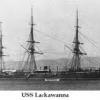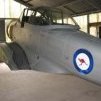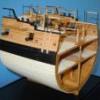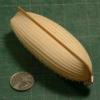MORE HANDBOOKS ARE ON THEIR WAY! We will let you know when they get here.
×
-
Posts
1,197 -
Joined
-
Last visited
Reputation Activity
-
 Stuntflyer got a reaction from Canute in Beavers Prize 1777 by Mike Y - 1:48 - POF - Hahn style
Stuntflyer got a reaction from Canute in Beavers Prize 1777 by Mike Y - 1:48 - POF - Hahn style
I'm smiling too Mike. Nice fairing work!
-
 Stuntflyer got a reaction from dgbot in Greenwich Hospital barge of 1832 by druxey - FINISHED - 1:48 scale
Stuntflyer got a reaction from dgbot in Greenwich Hospital barge of 1832 by druxey - FINISHED - 1:48 scale
This is definately a first for me Druxey. I have never had the pleasure of following any of your build logs. Let's just say that I'm very excited to see this one.
Mike
-
 Stuntflyer reacted to Erik W in HM Cutter Cheerful 1806 by Erik W - 1:48 scale
Stuntflyer reacted to Erik W in HM Cutter Cheerful 1806 by Erik W - 1:48 scale
I finished the first rough fairing on the port side. I've done a whole lot of sanding over the last week!! There are spots I need to touch up, particularly at the bow, but I'll wait to address those until I do the fairing after I frame the gun ports.
Erik
-
 Stuntflyer got a reaction from Captain Poison in HM Cutter Cheerful 1806 by Stuntflyer (Mike) - FINISHED - 1:48 scale
Stuntflyer got a reaction from Captain Poison in HM Cutter Cheerful 1806 by Stuntflyer (Mike) - FINISHED - 1:48 scale
I started lining off the deck today. . .
Using a tick strip, the deck beam reference line on the fore side of the main hatch was divided into equal segments. Mine needed eleven, each segment being slightly under 3/16". I divided the eleven spaces into two belts seven inner and four outer.
To establish the two belts down the length of the hull I decided to get the initial curve from the plan and adjust it later if needed on the deck itself. I had already made a copy of the plan sheet showing the deck. I made a few changes to the plan to correspond to the actual build. I placed a thin sheet of glass over the plan and used a ships curve and a fine line marking pen to draw the curve. Once I was satisfied with the run of the curve I placed 1/8" tape along the line directly to the glass.
A photo was taken and printed so the curve could be glued to card stock. Placing the curve on the deck showed that only a slight adjustment was needed at the location of the tick mark which divides the two belts. With the curve redrawn and a line transferred to both sides of the deck, I was ready to complete the remaining tick marks. Connecting the tick marks really helps to see what the run of planks will look like. In a few places I included the planks tab into the measurments and that was enough to throw off the even flow of planks down the hull. If I had not connected the tick marks it would have been very difficult to spot these errors.
Mike
-
 Stuntflyer got a reaction from Mike Y in Beavers Prize 1777 by Mike Y - 1:48 - POF - Hahn style
Stuntflyer got a reaction from Mike Y in Beavers Prize 1777 by Mike Y - 1:48 - POF - Hahn style
I'm smiling too Mike. Nice fairing work!
-
 Stuntflyer got a reaction from mtaylor in Beavers Prize 1777 by Mike Y - 1:48 - POF - Hahn style
Stuntflyer got a reaction from mtaylor in Beavers Prize 1777 by Mike Y - 1:48 - POF - Hahn style
I'm smiling too Mike. Nice fairing work!
-
 Stuntflyer reacted to mtaylor in Beavers Prize 1777 by Mike Y - 1:48 - POF - Hahn style
Stuntflyer reacted to mtaylor in Beavers Prize 1777 by Mike Y - 1:48 - POF - Hahn style
You got me smiling, Mike. The fairing looks great. I thought I was the only one who tried a plane on frames? I also used it sparingly on the planks when I could.
-
 Stuntflyer reacted to EdT in Young America 1853 by EdT - FINISHED - extreme clipper
Stuntflyer reacted to EdT in Young America 1853 by EdT - FINISHED - extreme clipper
Young America - extreme clipper 1853
Part 136 – Capstans 4
This post will wrap up the work on the two capstans. In the first picture 4 copper pawls have been added to the main deck capstan.
These are loosely bolted to the lower disk through the iron (i.e blackened copper) band. At full scale these would drop easily into the baseplate groove. At this scale they drop sometimes. These were made to be reversible. They could be flipped over to allow the capstan to work in the opposite rotation. In the next picture the pawls have been blackened with liver of sulfur d and flipped.
In the next picture one of the baseplates has been removed to add four pawl stops.
These are small (3” x 3” brass cubes. the black dabs in the picture are solder/flux paste. When the four cubes are fitted in place in contact with the paste the entire assembly was torched to flux the solder. The next picture shows the forecastle capstan set on its blacked, finished baseplate.
Both the base plate and the wood base were still loose at this point. The base plates were then epoxied into the wood bases. In the next picture small wood stops are being glued to the spindle to hold this entire assembly together while allowing the capstan to rotate on the baseplate/wood base assembly.
When the wood bases are glued to the deck, the brass pins at the base of the spindles fit into holes previously driled in the steps on the deck below. In the next two pictures the wood bases have been glued to the deck, completing the installation.
The two capstans rotate freely and are pretty reliably stopped when the rotation is reversed.
The next task is one I have been anticipating (and perhaps dreading) for some time – the bilge pumps.
Ed
-
 Stuntflyer got a reaction from Bobstrake in Greenwich Hospital barge of 1832 by druxey - FINISHED - 1:48 scale
Stuntflyer got a reaction from Bobstrake in Greenwich Hospital barge of 1832 by druxey - FINISHED - 1:48 scale
This is definately a first for me Druxey. I have never had the pleasure of following any of your build logs. Let's just say that I'm very excited to see this one.
Mike
-
 Stuntflyer got a reaction from PeteB in HM Cutter Cheerful 1806 by Stuntflyer (Mike) - FINISHED - 1:48 scale
Stuntflyer got a reaction from PeteB in HM Cutter Cheerful 1806 by Stuntflyer (Mike) - FINISHED - 1:48 scale
I started lining off the deck today. . .
Using a tick strip, the deck beam reference line on the fore side of the main hatch was divided into equal segments. Mine needed eleven, each segment being slightly under 3/16". I divided the eleven spaces into two belts seven inner and four outer.
To establish the two belts down the length of the hull I decided to get the initial curve from the plan and adjust it later if needed on the deck itself. I had already made a copy of the plan sheet showing the deck. I made a few changes to the plan to correspond to the actual build. I placed a thin sheet of glass over the plan and used a ships curve and a fine line marking pen to draw the curve. Once I was satisfied with the run of the curve I placed 1/8" tape along the line directly to the glass.
A photo was taken and printed so the curve could be glued to card stock. Placing the curve on the deck showed that only a slight adjustment was needed at the location of the tick mark which divides the two belts. With the curve redrawn and a line transferred to both sides of the deck, I was ready to complete the remaining tick marks. Connecting the tick marks really helps to see what the run of planks will look like. In a few places I included the planks tab into the measurments and that was enough to throw off the even flow of planks down the hull. If I had not connected the tick marks it would have been very difficult to spot these errors.
Mike
-
 Stuntflyer reacted to Mike Y in Beavers Prize 1777 by Mike Y - 1:48 - POF - Hahn style
Stuntflyer reacted to Mike Y in Beavers Prize 1777 by Mike Y - 1:48 - POF - Hahn style
Finished the most risky part of the fairing - the outer surface of the side that would be opened.
Lesson for the future - if you add the bolt simulation - add another millimiter of margin to the frame lines, especially on the sides of the hull (it is unlikely that the bottom would be problematic).
Ended up with some really thin sides around the midship:
But overall - nothing is screwed up! Just some bolts that are too close to the edge of the frame, but they are not poking to the side!
No finish applied, and will sand with fine grits right before finishing - apparently, finger marks are very visible.
The transom wings required a lot of shaping! You can compare with the non-faired side on the right.
I tried lots of different tools for fairing, but ended up with this set:
Cork block shaped to be round on one side, and remains flat on another. Sandpaper - Mirka 120 grit.
Semi-flexible yellow thingy was very useful when sanding the bow and transom. Right the exact flex! Grit 90.
French curve scraper helped to level the frames, especially in the tight areas. In another areas, miniature chisel was used for that.
Surprisingly, block plane was very useful to quickly even out the frames, to later finish it with the sanding block.
-
 Stuntflyer reacted to Chuck in Greenwich Hospital barge of 1832 by druxey - FINISHED - 1:48 scale
Stuntflyer reacted to Chuck in Greenwich Hospital barge of 1832 by druxey - FINISHED - 1:48 scale
So fantastic to see this log.....I cant wait to see the decorative work and small fiddly bits take shape.
Chuck
-
 Stuntflyer got a reaction from GuntherMT in HM Cutter Cheerful 1806 by Stuntflyer (Mike) - FINISHED - 1:48 scale
Stuntflyer got a reaction from GuntherMT in HM Cutter Cheerful 1806 by Stuntflyer (Mike) - FINISHED - 1:48 scale
I started lining off the deck today. . .
Using a tick strip, the deck beam reference line on the fore side of the main hatch was divided into equal segments. Mine needed eleven, each segment being slightly under 3/16". I divided the eleven spaces into two belts seven inner and four outer.
To establish the two belts down the length of the hull I decided to get the initial curve from the plan and adjust it later if needed on the deck itself. I had already made a copy of the plan sheet showing the deck. I made a few changes to the plan to correspond to the actual build. I placed a thin sheet of glass over the plan and used a ships curve and a fine line marking pen to draw the curve. Once I was satisfied with the run of the curve I placed 1/8" tape along the line directly to the glass.
A photo was taken and printed so the curve could be glued to card stock. Placing the curve on the deck showed that only a slight adjustment was needed at the location of the tick mark which divides the two belts. With the curve redrawn and a line transferred to both sides of the deck, I was ready to complete the remaining tick marks. Connecting the tick marks really helps to see what the run of planks will look like. In a few places I included the planks tab into the measurments and that was enough to throw off the even flow of planks down the hull. If I had not connected the tick marks it would have been very difficult to spot these errors.
Mike
-
 Stuntflyer got a reaction from wyz in HM Cutter Cheerful 1806 by Stuntflyer (Mike) - FINISHED - 1:48 scale
Stuntflyer got a reaction from wyz in HM Cutter Cheerful 1806 by Stuntflyer (Mike) - FINISHED - 1:48 scale
I started lining off the deck today. . .
Using a tick strip, the deck beam reference line on the fore side of the main hatch was divided into equal segments. Mine needed eleven, each segment being slightly under 3/16". I divided the eleven spaces into two belts seven inner and four outer.
To establish the two belts down the length of the hull I decided to get the initial curve from the plan and adjust it later if needed on the deck itself. I had already made a copy of the plan sheet showing the deck. I made a few changes to the plan to correspond to the actual build. I placed a thin sheet of glass over the plan and used a ships curve and a fine line marking pen to draw the curve. Once I was satisfied with the run of the curve I placed 1/8" tape along the line directly to the glass.
A photo was taken and printed so the curve could be glued to card stock. Placing the curve on the deck showed that only a slight adjustment was needed at the location of the tick mark which divides the two belts. With the curve redrawn and a line transferred to both sides of the deck, I was ready to complete the remaining tick marks. Connecting the tick marks really helps to see what the run of planks will look like. In a few places I included the planks tab into the measurments and that was enough to throw off the even flow of planks down the hull. If I had not connected the tick marks it would have been very difficult to spot these errors.
Mike
-
 Stuntflyer got a reaction from Archi in HM Cutter Cheerful 1806 by Stuntflyer (Mike) - FINISHED - 1:48 scale
Stuntflyer got a reaction from Archi in HM Cutter Cheerful 1806 by Stuntflyer (Mike) - FINISHED - 1:48 scale
I started lining off the deck today. . .
Using a tick strip, the deck beam reference line on the fore side of the main hatch was divided into equal segments. Mine needed eleven, each segment being slightly under 3/16". I divided the eleven spaces into two belts seven inner and four outer.
To establish the two belts down the length of the hull I decided to get the initial curve from the plan and adjust it later if needed on the deck itself. I had already made a copy of the plan sheet showing the deck. I made a few changes to the plan to correspond to the actual build. I placed a thin sheet of glass over the plan and used a ships curve and a fine line marking pen to draw the curve. Once I was satisfied with the run of the curve I placed 1/8" tape along the line directly to the glass.
A photo was taken and printed so the curve could be glued to card stock. Placing the curve on the deck showed that only a slight adjustment was needed at the location of the tick mark which divides the two belts. With the curve redrawn and a line transferred to both sides of the deck, I was ready to complete the remaining tick marks. Connecting the tick marks really helps to see what the run of planks will look like. In a few places I included the planks tab into the measurments and that was enough to throw off the even flow of planks down the hull. If I had not connected the tick marks it would have been very difficult to spot these errors.
Mike
-
 Stuntflyer got a reaction from dvm27 in HM Cutter Cheerful 1806 by Stuntflyer (Mike) - FINISHED - 1:48 scale
Stuntflyer got a reaction from dvm27 in HM Cutter Cheerful 1806 by Stuntflyer (Mike) - FINISHED - 1:48 scale
I started lining off the deck today. . .
Using a tick strip, the deck beam reference line on the fore side of the main hatch was divided into equal segments. Mine needed eleven, each segment being slightly under 3/16". I divided the eleven spaces into two belts seven inner and four outer.
To establish the two belts down the length of the hull I decided to get the initial curve from the plan and adjust it later if needed on the deck itself. I had already made a copy of the plan sheet showing the deck. I made a few changes to the plan to correspond to the actual build. I placed a thin sheet of glass over the plan and used a ships curve and a fine line marking pen to draw the curve. Once I was satisfied with the run of the curve I placed 1/8" tape along the line directly to the glass.
A photo was taken and printed so the curve could be glued to card stock. Placing the curve on the deck showed that only a slight adjustment was needed at the location of the tick mark which divides the two belts. With the curve redrawn and a line transferred to both sides of the deck, I was ready to complete the remaining tick marks. Connecting the tick marks really helps to see what the run of planks will look like. In a few places I included the planks tab into the measurments and that was enough to throw off the even flow of planks down the hull. If I had not connected the tick marks it would have been very difficult to spot these errors.
Mike
-
 Stuntflyer got a reaction from druxey in HM Cutter Cheerful 1806 by Stuntflyer (Mike) - FINISHED - 1:48 scale
Stuntflyer got a reaction from druxey in HM Cutter Cheerful 1806 by Stuntflyer (Mike) - FINISHED - 1:48 scale
I started lining off the deck today. . .
Using a tick strip, the deck beam reference line on the fore side of the main hatch was divided into equal segments. Mine needed eleven, each segment being slightly under 3/16". I divided the eleven spaces into two belts seven inner and four outer.
To establish the two belts down the length of the hull I decided to get the initial curve from the plan and adjust it later if needed on the deck itself. I had already made a copy of the plan sheet showing the deck. I made a few changes to the plan to correspond to the actual build. I placed a thin sheet of glass over the plan and used a ships curve and a fine line marking pen to draw the curve. Once I was satisfied with the run of the curve I placed 1/8" tape along the line directly to the glass.
A photo was taken and printed so the curve could be glued to card stock. Placing the curve on the deck showed that only a slight adjustment was needed at the location of the tick mark which divides the two belts. With the curve redrawn and a line transferred to both sides of the deck, I was ready to complete the remaining tick marks. Connecting the tick marks really helps to see what the run of planks will look like. In a few places I included the planks tab into the measurments and that was enough to throw off the even flow of planks down the hull. If I had not connected the tick marks it would have been very difficult to spot these errors.
Mike
-
 Stuntflyer got a reaction from egkb in HM Cutter Cheerful 1806 by Stuntflyer (Mike) - FINISHED - 1:48 scale
Stuntflyer got a reaction from egkb in HM Cutter Cheerful 1806 by Stuntflyer (Mike) - FINISHED - 1:48 scale
I started lining off the deck today. . .
Using a tick strip, the deck beam reference line on the fore side of the main hatch was divided into equal segments. Mine needed eleven, each segment being slightly under 3/16". I divided the eleven spaces into two belts seven inner and four outer.
To establish the two belts down the length of the hull I decided to get the initial curve from the plan and adjust it later if needed on the deck itself. I had already made a copy of the plan sheet showing the deck. I made a few changes to the plan to correspond to the actual build. I placed a thin sheet of glass over the plan and used a ships curve and a fine line marking pen to draw the curve. Once I was satisfied with the run of the curve I placed 1/8" tape along the line directly to the glass.
A photo was taken and printed so the curve could be glued to card stock. Placing the curve on the deck showed that only a slight adjustment was needed at the location of the tick mark which divides the two belts. With the curve redrawn and a line transferred to both sides of the deck, I was ready to complete the remaining tick marks. Connecting the tick marks really helps to see what the run of planks will look like. In a few places I included the planks tab into the measurments and that was enough to throw off the even flow of planks down the hull. If I had not connected the tick marks it would have been very difficult to spot these errors.
Mike
-
 Stuntflyer got a reaction from tlevine in HM Cutter Cheerful 1806 by Stuntflyer (Mike) - FINISHED - 1:48 scale
Stuntflyer got a reaction from tlevine in HM Cutter Cheerful 1806 by Stuntflyer (Mike) - FINISHED - 1:48 scale
I started lining off the deck today. . .
Using a tick strip, the deck beam reference line on the fore side of the main hatch was divided into equal segments. Mine needed eleven, each segment being slightly under 3/16". I divided the eleven spaces into two belts seven inner and four outer.
To establish the two belts down the length of the hull I decided to get the initial curve from the plan and adjust it later if needed on the deck itself. I had already made a copy of the plan sheet showing the deck. I made a few changes to the plan to correspond to the actual build. I placed a thin sheet of glass over the plan and used a ships curve and a fine line marking pen to draw the curve. Once I was satisfied with the run of the curve I placed 1/8" tape along the line directly to the glass.
A photo was taken and printed so the curve could be glued to card stock. Placing the curve on the deck showed that only a slight adjustment was needed at the location of the tick mark which divides the two belts. With the curve redrawn and a line transferred to both sides of the deck, I was ready to complete the remaining tick marks. Connecting the tick marks really helps to see what the run of planks will look like. In a few places I included the planks tab into the measurments and that was enough to throw off the even flow of planks down the hull. If I had not connected the tick marks it would have been very difficult to spot these errors.
Mike
-
 Stuntflyer got a reaction from PeteB in HM Cutter Cheerful 1806 by Stuntflyer (Mike) - FINISHED - 1:48 scale
Stuntflyer got a reaction from PeteB in HM Cutter Cheerful 1806 by Stuntflyer (Mike) - FINISHED - 1:48 scale
The margin planks are done. .
The only way that I could get the four sections of planks located between the stern frames at the same angle was to add shims onto the false deck. You can see where I placed them between the stern frames on the port side. The shims taper across the deck from 1/64" to less than 1/32". Without them the two sections on the port side would have dropped too much. Prior to installing these four pieces I could see where the false deck was slightly lower on the port side near the counter.
The scarph joints were made with a #11 blade and some needle files. I went slowly, spending time trying to get a close fit. I also had to figure out the proper length of each section so the joints would center between the gun ports. The three long sections on each side were joined, sanded and given a coat of W-O-P off the ship prior to placing them into the hull.
I decided to soften the inside edge of the caprail. It's a small thing but it does make the overall appearance better, I think. I'm also refining the paint work around the fashion pieces as you can see. I'm not in any hurry to finish painting around the caprail since other parts have to be installed on top, which would only require more sanding and painting.
-
 Stuntflyer got a reaction from PeteB in HM Cutter Cheerful 1806 by Stuntflyer (Mike) - FINISHED - 1:48 scale
Stuntflyer got a reaction from PeteB in HM Cutter Cheerful 1806 by Stuntflyer (Mike) - FINISHED - 1:48 scale
Planking the deck is not exactly what I would call a milestone though it does feel like I'm moving along. . .
Though not very scientific, I did come up with a way to get those center planks in a straight line. After setting the first plank at the stern I used a card template at each location along the deck to keep the planks straight. To confirm alignment, I marked the center of the plank at its forward edge as well as the aft edge of the deck structure. After pulling the plank to the card template I could see whether or not two marks matched closely
The four remaining planks (two on each side of center plank) where then installed using PVA and clamps. I was careful not to glue anywhere close to the red deck structures. Scrap strips were used between the clamp and the deck planking to avoid any dents that might be caused from tightening of the clamps. I don't have any of those high-tech wooden clamps like those used by EdT though the ones from Dewalt (found at Home Depot) worked well enough. The clamp's protective covers were removed in order to get a better grip on the planks. The Irwin Quick-Grips have a more rounded shape underneath the covers and tend to slip off too easily.
My deck planks are approximately 3/16" wide and in various locations will have a small tab. These have to be made using a wider strip. I tried making one that would have been 7/32" at its widest point using a 7/32" strip. Guess what, it didn't work. There wasn't enough room to allow for adjustments to the shape. I decided to go with a 1/4" strip, which worked quite well. Once the shape was completed it was only a matter of reducing the width to 3/16" outside of the tab location. This is an important step if you want to maintain consistency to the overall look of the planking.
This is the plank which goes on either side of the "ventilation scuttle grating", just behind the skylight.
Once the first five rows were completed, excess glue was removed and the planks were lightly sanded. I will hold off doing the final sanding until all of the remaining planks are in.
-
 Stuntflyer got a reaction from Jack12477 in HM Cutter Cheerful 1806 by Stuntflyer (Mike) - FINISHED - 1:48 scale
Stuntflyer got a reaction from Jack12477 in HM Cutter Cheerful 1806 by Stuntflyer (Mike) - FINISHED - 1:48 scale
I started lining off the deck today. . .
Using a tick strip, the deck beam reference line on the fore side of the main hatch was divided into equal segments. Mine needed eleven, each segment being slightly under 3/16". I divided the eleven spaces into two belts seven inner and four outer.
To establish the two belts down the length of the hull I decided to get the initial curve from the plan and adjust it later if needed on the deck itself. I had already made a copy of the plan sheet showing the deck. I made a few changes to the plan to correspond to the actual build. I placed a thin sheet of glass over the plan and used a ships curve and a fine line marking pen to draw the curve. Once I was satisfied with the run of the curve I placed 1/8" tape along the line directly to the glass.
A photo was taken and printed so the curve could be glued to card stock. Placing the curve on the deck showed that only a slight adjustment was needed at the location of the tick mark which divides the two belts. With the curve redrawn and a line transferred to both sides of the deck, I was ready to complete the remaining tick marks. Connecting the tick marks really helps to see what the run of planks will look like. In a few places I included the planks tab into the measurments and that was enough to throw off the even flow of planks down the hull. If I had not connected the tick marks it would have been very difficult to spot these errors.
Mike
-
 Stuntflyer got a reaction from mtaylor in HM Cutter Cheerful 1806 by Stuntflyer (Mike) - FINISHED - 1:48 scale
Stuntflyer got a reaction from mtaylor in HM Cutter Cheerful 1806 by Stuntflyer (Mike) - FINISHED - 1:48 scale
I started lining off the deck today. . .
Using a tick strip, the deck beam reference line on the fore side of the main hatch was divided into equal segments. Mine needed eleven, each segment being slightly under 3/16". I divided the eleven spaces into two belts seven inner and four outer.
To establish the two belts down the length of the hull I decided to get the initial curve from the plan and adjust it later if needed on the deck itself. I had already made a copy of the plan sheet showing the deck. I made a few changes to the plan to correspond to the actual build. I placed a thin sheet of glass over the plan and used a ships curve and a fine line marking pen to draw the curve. Once I was satisfied with the run of the curve I placed 1/8" tape along the line directly to the glass.
A photo was taken and printed so the curve could be glued to card stock. Placing the curve on the deck showed that only a slight adjustment was needed at the location of the tick mark which divides the two belts. With the curve redrawn and a line transferred to both sides of the deck, I was ready to complete the remaining tick marks. Connecting the tick marks really helps to see what the run of planks will look like. In a few places I included the planks tab into the measurments and that was enough to throw off the even flow of planks down the hull. If I had not connected the tick marks it would have been very difficult to spot these errors.
Mike
-
 Stuntflyer reacted to BobF in 18th Century Longboat by BobF - FINISHED - Model Shipways - 1:48 - Tri-Club
Stuntflyer reacted to BobF in 18th Century Longboat by BobF - FINISHED - Model Shipways - 1:48 - Tri-Club
Ever since I saw samueljr's model on this forum, I've been intrigued with the possibility of incorporating a pulley into the cap rail at the bow. Samuel's model has the bowsprit to the port side, and the pulley on the starboard side, which is also correct. Apparently, it was done both ways.
It wasn't until I saw photos of two contemporary models that had the pulley on the port side that I decided to go for it. One model was rigged, and the other was not. As much as I would like to show you those photos, I thought better of it, considering the current ongoing discussion on copyrights.
Once I got passed the decision to do surgery on the painted model, the modification was not that difficult. The cap rail overhang was trimmed down, and the new piece was fabricated. Contemporary models seem to indicate that these pieces were actually separate from the cap rail, so the modification did not impact the accuracy of the model.
On some contemporary models, this piece feathers nicely into the cap rail edge, and on others there is a distinct slight bump at the aft end. I opted for the latter version.
A closer study of the reference photos showed that the starboard side also had the same shaped piece, but no allowances were made for a pulley, since the bowsprit would have been mounted on that side. I'm currently working on that piece.
BobF
-
 Stuntflyer got a reaction from mtaylor in HM Cutter Cheerful 1806 by Erik W - 1:48 scale
Stuntflyer got a reaction from mtaylor in HM Cutter Cheerful 1806 by Erik W - 1:48 scale
Looks really good!
Mike














